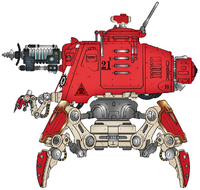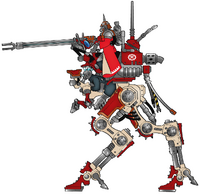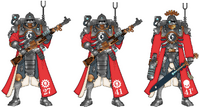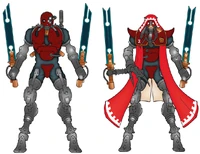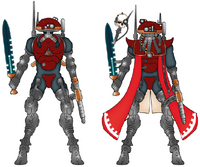m (→Gallery: "Its" is the possessive form.) Tag: sourceedit |
No edit summary Tag: rte-source |
||
| Line 4: | Line 4: | ||
|type=[[Forge World]] |
|type=[[Forge World]] |
||
|orbdist=1.524 AU |
|orbdist=1.524 AU |
||
| − | |gravity=38% Terran normal |
+ | |gravity=38% Terran normal (.38 G) |
|temp=average -63° C high 27° C low -140° C |
|temp=average -63° C high 27° C low -140° C |
||
|pop=20,000,000,000 |
|pop=20,000,000,000 |
||
Revision as of 16:38, 30 March 2017
Mars, also known as "The Red Planet," is the greatest Forge World of the Imperium of Man, producing vast numbers of weapons, vehicles and other technology for the Imperial war efforts throughout the galaxy. Mars is also the homeworld and headquarters of the Adeptus Mechanicus and a planet sacred to the faith of the Cult Mechanicus, which is one reason why travel to the Red Planet for Imperial personnel who are not members of the Mechanicus and share its peculiar faith is restricted. Mars is encircled by a massive conglomeration of thousands of drydocks and other starship manufacturing facilities that encircle the Red Planet in a geosynchronous equatorial orbit that is known as the Ring of Iron. It was the shipyards of the Ring of Iron that constructed the vast exploratory and expeditionary fleets of the Great Crusade and even today produce the majority of the Imperial Navy's capital ships. It is possible that Mars is also the world where the ancient and terrible C'tan known as the Void Dragon has chosen to slumber the eons away.
History
Mars is the twin planet of Terra, and one of many long-inhabited colony worlds located near the Cradle of Humanity. It is the homeworld and primary power centre of the Adeptus Mechanicus, the ancient and byzantine priesthood of the Machine God, and the heart of their galaxy-spanning monopoly on human science and technology. Following the Unification Wars in which the Emperor of Mankind defeated the techno-barbarians of Terra and reunited humanity's homeworld under a single government, he concluded the Treaty of Mars (known as the Treaty of Olympus within the Mechanicus) with the Cult Mechanicus to unify both Terra and Mars under the umbrella of the newborn Imperium of Man in the 30th Millennium. The Mechanicus recognised the Emperor as the Omnissiah incarnate and swore to lend their technology, the mighty war machines of their Titan Legions and all of their production facilities to the purpose of his Great Crusade to reunite all the scattered worlds of Mankind beneath the rule of the Imperium. In return, the Emperor promised the Mechanicus that it could maintain its political autonomy on Mars and all of its other Forge Worlds and that it would remain immune from adherence to the atheistic doctrines of the Imperial Truth. This ensured that the Adepts of the Mechanicus could still maintain their faith in the Machine God. Therefore, Mars is just as important to the Imperium's survival as Terra itself.
More than any other world, Mars possesses huge repositories of technical knowledge. Its immense libraries and databanks are highly eclectic and disorganised; one delving for secrets may find a crystal storage device containing vital genetor-level data tucked inside a scrollprint for militarised locomotives. The planet itself is a wilderness of polluted ochre desert broken by metropolises the size of tectonic plates. Here the rockcrete spires, marble arches and flying buttresses of a standard Imperial world are joined by corroded steel, iron ventilation chimneys and shining glass pipes. Extensive travel tubes pass above crackling tesla coils that power construction sites and ancient industrial wastes alike. Shining new buildings braced with riggings of steel contrast with shattered condensation traps and the ruins of millennial wars. The older districts are dotted with broken plasteel slabs and twisted girders, the occasional solitary tower pointing purposelessly toward the Martian sky. In ancient times, Mars had a fully terraformed atmosphere and ecosystems very similar to that of ancient Terra during the Dark Age of Technology, but the constant warfare of the Age of Strife destroyed the world's manufactured oxygen-nitrogen atmosphere and restored the Red Planet's surface to its primordial desert state, absent surface water and breathable oxygen. The only inhabitable regions of the planet are now the Adeptus Mechanicus' Hive Cities.
Mars is strictly stratified in its social order. Mars is ruled over by the Adeptus Mechanicus' Fabricator General, and he possesses almost every known piece of Standard Template Construct (STC) technology or designs currently in Imperial hands. This is ostensibly so he can construct better and more durable vehicles and technology for the Imperium, although it is fairly clear that the Mechanicus is simply hoarding them. The lowest level consists of the citizens, mainly unaugmented human populations who labour en masse at simple tasks such as sorting isotope scrap, tending hydroponics, breaking ore, stoking forges and so on. Most citizens aspire to gaining status by joining the Skitarii. In the process, they will receive their first battle-grade bionics and perhaps a way of later entering the priesthood. Lesser citizens may sport tattoos and piercings suggestive of such bionics, but dress in common work clothes – filthy coveralls, rad-tabards or cabled environ-suits. Regardless of station, Martians have a tendency to be burly, saturnine and shaven headed, usually with a temper to match their dour aspect. All sport electoos -- subcutaneous cyberware that ranges from code-patches through which personal data is monitored to thick veins of electric cabling. Through these electoo circuits can the glory of the Omnissiah be channelled. In times of great strife, the masters of Mars' populace can use these interfaces to turn even the most gormless hab-worker into a dauntless warrior of the Machine God.
It is also rumoured that the most powerful of the C'tan, the Void Dragon, sleeps somewhere beneath the surface of Mars, in the Noctis Labyrinth, and its presence may be the reason why Necron starships briefly landed on the Red Planet in 997.M41. Should the Void Dragon awake, the very heart of the Imperium will tremble.
Military Forces
Legiones Skitarii
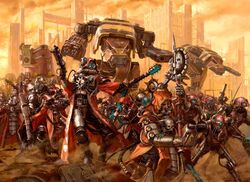
A Skitarii Cohort of Mars
Mars' Skitarii Legion is the most glorious of all its kind. Its warriors consider it a great privilege to wear the ancient heraldry of the Red Planet, and are fiercely defensive of their Forge World despite its unchallenged position of power. Perhaps because of the acquisitive nature of their masters, the red, silver and black of Mars' War Cohorts is a common sight in each segmentum of the Imperium. Each Skitarius is but a single cog in a war machine that spans the entire Imperium. Controlled by the neurosync imperatives of their masters, the Skitarii are organised into War Cohorts capable of overcoming any foe. They work in glorious concert, every footstep or twitch of the trigger finger optimised to further the cause of the Cult Mechanicus. The original maniples that crossed the desert reaches of Mars on foot were armed only with galvanic rifles. They escorted their masters from north to south across an equatorial belt infested with cannibal servitors and rogue machine intelligences. As the centuries marched past, these escorts were refined over and over again until they evolved into the Battle Maniples of the 41st Millennium. Many variants have been codified, from the Maniples Automata of the Legio Cybernetica to the teeming Auxilia Ordinatus, but the core fighting formation remains the War Cohort.
Like it's fellow Forge Worlds, Mar's Skitarii Legion is divided into a number of macroclades, which are in turn broken down into cohorts and maniples. The vast majority of Skitarii War Cohorts are not borne into battle by armoured machines or aircraft, but simply stride to the front line without stopping, even should they have to start the journey months in advance of their allies. They will wade through poisonous swamps and bubbling lakes of tar to arrive at the front line on schedule, rank upon rank of Skitarii marching around chains of Onager Dunecrawlers in imitation of Mars' nomadic caravanserais. Their tireless pace echoes the constancy of their dutiful souls -- it is said that a Skitarius would rather walk himself to death than disobey a direct imperative.
Mars Appearance
Mars Iconography

The official Imperial stamp of the Forge World of Mars
The holy cog-and-skull of Mars graces many Skitarii warriors and vehicles, a reminder that all must play their part in the greater war machine of the Adeptus Mechanicus.
Mars Forge World Colours
Like other Forge Worlds, Mars maintains its own Skitarii forces to protect it's interests, annihilate the enemies of the Tech-Priests, and fight at the vanguard of the Quest for Knowledge. Skitarii Vanguard and Skitarii Rangers alike wear combat robes emblazoned with the icon of their Forge World. Skitarii infantry usually have their squad number emblazoned upon the hem of their robes for easy identification. Some specialist units, such as Sicarian Ruststalkers and Infiltrators, may wear a number on their helm or chestplate. The Alphas and Princeps of the Skitarii legions often bear a skull in place of their Forge World icon. They may also display their maniple sigil, either appended to the squad number on their war robes, or on their chestplate or helm. The armour plates of Skitarii vehicles are the same hue as those worn by the legion's Sicarians.
Planetary Data

Map of Mars' Tharsis region at the time of the Horus Heresy in the 31st Millennium
- Mass: 6.42 x 10^23 kg
- Diameter: 6787 km
- Mean density: 3940 kg/m^3
- Escape velocity: 5000 m/sec
- Avg. distance from Sun: 1.524 AU
- Rotation period: 1.026 days
- Revolution period: 686.98 days
- Obliquity: 25°
- Orbit inclination degree): 1.85°
- Orbit eccentricity: .0.093°
- Max. surface temperature: 310° K
- Min. surface temperature: 150° K
- Visual geometric albedo: 0.15
- Highest point on surface: Olympus Mons
- Atmospheric components: 95% carbon dioxide, 3% nitrogen, 1.6% argon
- Surface materials: basaltic rock and altered materials
Notable Locations
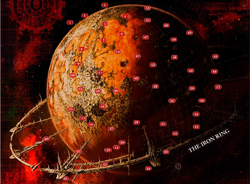
Pict-Capture of Mars, the First Forge World, showing key locations
Key
- 1. Glaivid Hive
- 2. Oxygos Hive
- 3. Olympus Undae Hive
- 4. Hyperboreae Undae
- 5. Collegia Titanica
- 6. Mare Chronius
- 7. Tantalus Hive
- 8. Milancovic Fusion Reactor
- 9. Arcadia solar collector fields
- 10. Omnid Apertura
- 11. The Grand Temple of the Omnissiah
- 12. Mareotis Forge Temple
- 13. Acheron Fosse forge temples
- 14. Arsia Mons
- 15. Fabricator General Forge Temple
- 16. Temple of the Frictionless Piston
- 17. Temple of All Knowledge
- 18. Deep core mines
- 19. Ascraeus Mons
- 20. Dodecai Elevatus Prime
- 21. Dodecai Elevatus Secundus
- 22. Imperial Navy assembly yards
- 23. Esperanos Space Port
- 24. Deus Manus Space Port
- 25. Ipluvien Maximal
- 26. Fortress temple of Knights Taranis
- 27. Pavonis Mons
- 28. Imperial Navy Mars Docks
- 29. Xanthos
- 30. Fortress temple of Legio Tempestus
- 31. Noctis Labyrinthus (Anathemor)
- 32. Haunted Dunes of Solis Planum
- 33. Candor Casma
- 34. Varnalia
- 35. Mondus Terrawatt II complex
- 36. Lybia Montes forge temples
- 37. Lethe Zone
- 38. Antionradi Forge Temple
- 39. Mondus Gamma Forge Temple
- 40. Mechavitae Forge Temple
- 41. The Rust Wastes
- 42. Cthonia
- 43. Autonoct Deserts
- 44. Sornia
- 45. Nilosyrtis Hive
- 46. Sydonian Tetrahedra
- 47. Protoservitor Cradle
- 48. Sydonian Mistsea
- 49. Sydonian Mask
- 50. Acidalia Planitia
- 51. Sea of Iron Curses
- 52. Vastitas Borealis
Sources
- Codex Imperialis (2nd Edition), pg. 42
- Codex: Necrons (3rd Edition), pg. 11
- Codex: Skitarii (7th Edition), pp. 22-27, 55-64
- Horus Heresy: Collected Visions, pg. 369
- The Horus Heresy - Book One: Betrayal by Alan Bligh, pg. 16
- Warhammer 40,000 Rulebook (5th Edition)
- White Dwarf 178 (UK), "The Titan Legions," by Rick Priestley
- Mechanicum (Novel) by Graham McNeill



